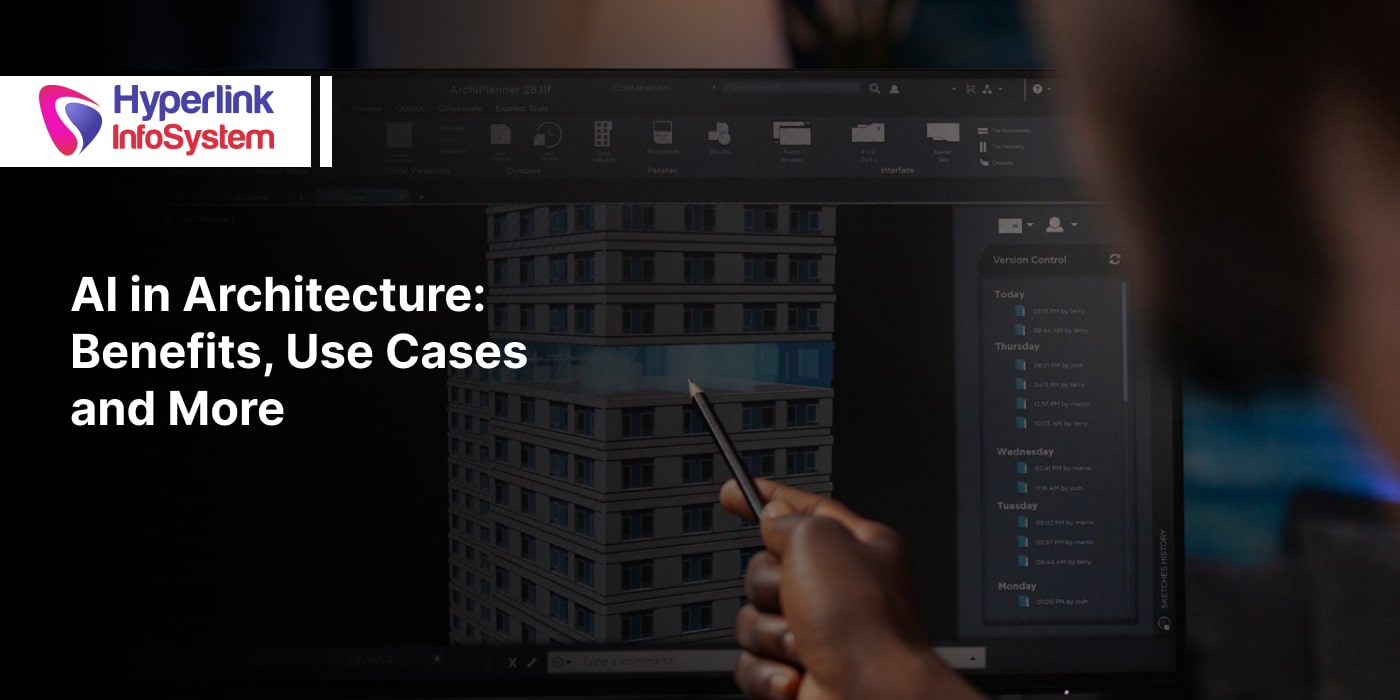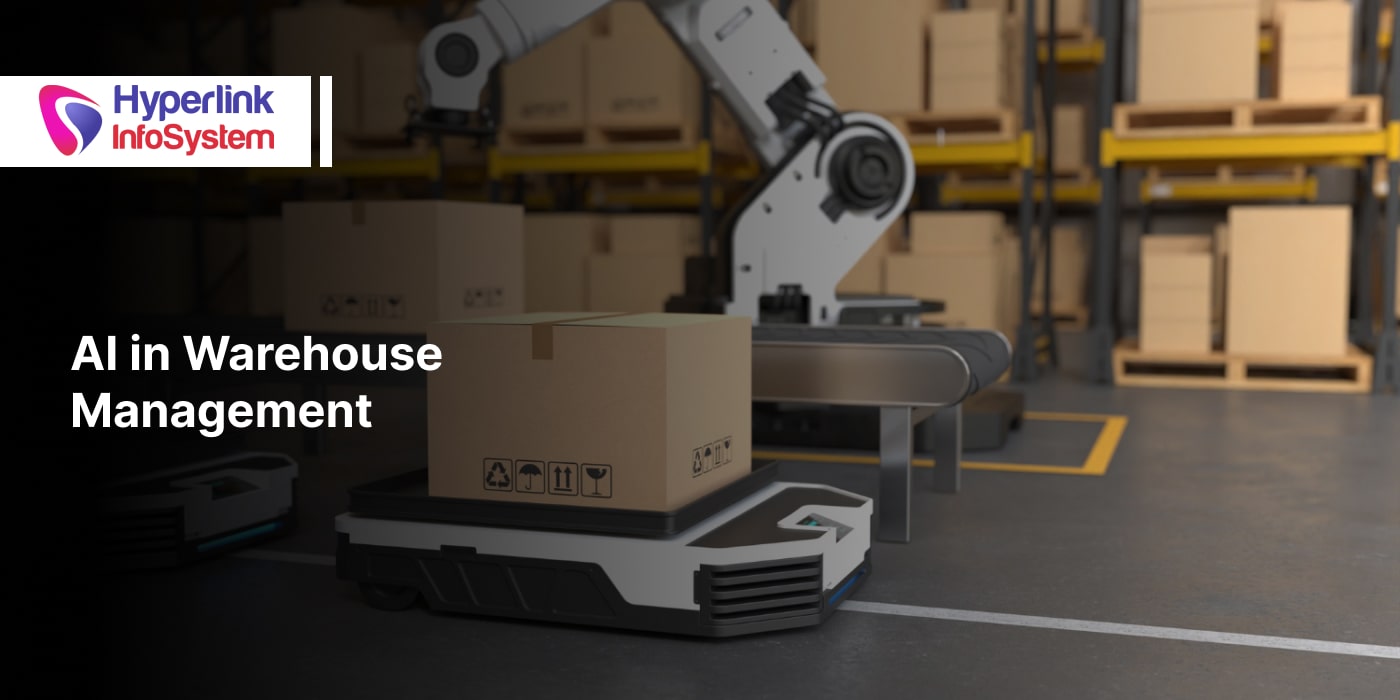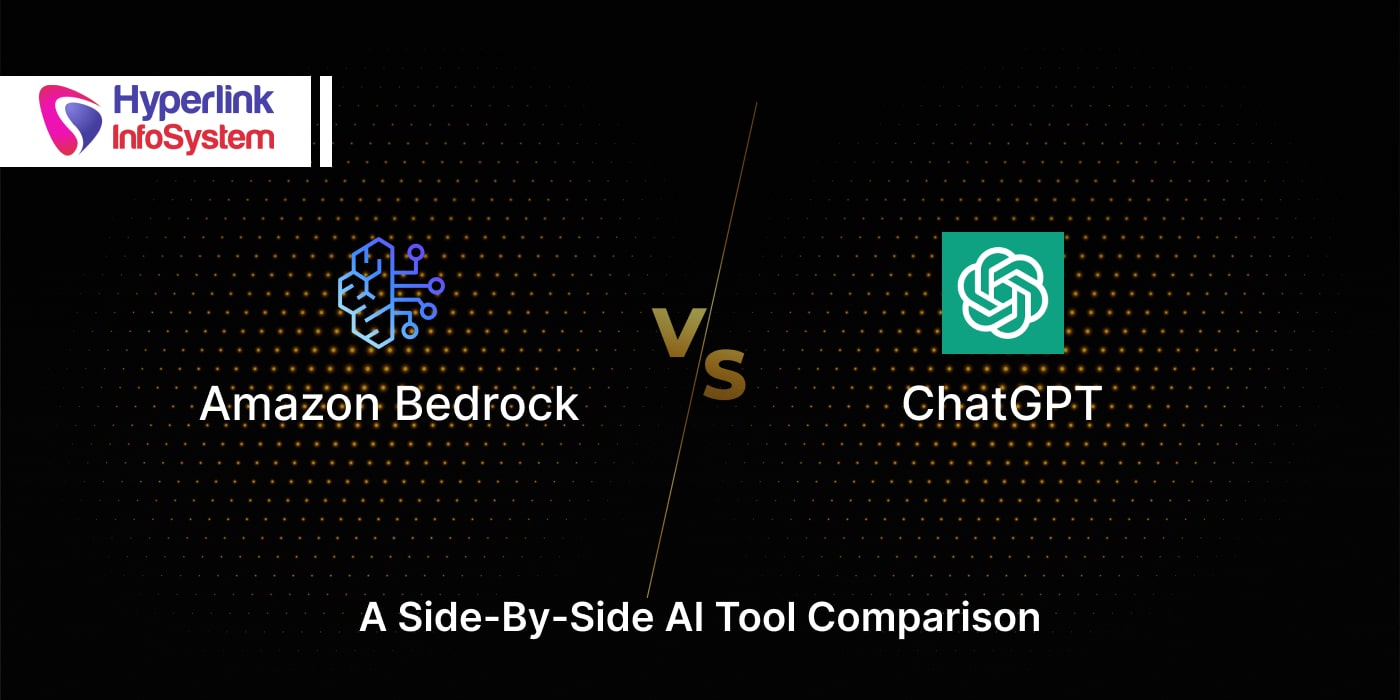AI in Architecture: Benefits, Use Cases and More
Jul 2024

The world of architecture is miraculously marvelous and is continuously evolving. AI-powered technologies like AR and VR, Natural Language Processing (NLP), and Machine Learning tools are being integrated in this sector to create innovative solutions to conventional challenges all while opening up new avenues for entrepreneurs. By harnessing the potential AI has to offer, architects and construction businesses can not just improve efficiency, but also obtain more precise accuracy, and also yield modern methodologies that are sustainable and cost-effective projects.
The construction sector is on the verge of a revolution, thanks to incredible breakthroughs in architecture, improved security measures, and increased overall efficiency, all while using the actual potential of AI, ML, and deep learning. AI and machine learning in construction can assist with predictive analytics, optimizing daily operations, and making data-driven decisions to improve functionality and profitability. Artificial intelligence (AI) is a wide term that describes the phenomenon in which a computer replicates human cognitive functions such as pattern recognition, learning, and problem solving. Machine learning is essentially a subset of AI. It is a broad subset of artificial intelligence that employs statistical methods to encourage computer systems to remember and comprehend data without the use of explicit programming.
Being on the cusp of a revolution and driven by the transformation powers of AI. AI in architecture helps create a future where buildings adapt to human demands and maximize efficiency and sustainability via reflexive design. Utilizing data analytics services and AI, architecture can push the boundaries of creativity and ingenuity, and create new and exciting opportunities. In this blog, we are going to discuss the role of AI in architecture, AI-driven design tools, use cases, and potential implementation challenges.
Role Of Artificial Intelligence In Architecture
The United Nations has projected that the global population will cross a whopping 12 billion, hence concluding that the need for planned cities, residential areas, and public spaces will be vital for efficient urban infrastructure. The rise of global urbanization is compelling urban planners, engineers, and architects to craft solutions to support this explosive population surge. Hence, AI integration in architecture has become increasingly influential in construction and design. AI in architecture is all about leveraging the potential of AI-powered technologies like AR and VR for enhancing architectural design, streamlining planning, and optimizing construction processes.
In 2024, AI-based architecture is currently churning and segregating enormous databases, working as a digital design partner, and producing structural configurations that are sustainable, efficient, and visually stunning. AI-powered technologies like AR and VR enable architects to get lost in the world of immersive designs and refine new-age concepts with creativity and precision. Additionally, AI’s predictive maintenance feature greatly improves building operations, ensuring functionality and durability in the long run.
Key Benefits of AI in Architecture
Let's check out some of the main benefits that AI offers for the architecture industry:
- Optimized Design Quality
Architects benefit greatly from utilizing AI integration in architecture to streamline the design of structures. Using AI's incredible capabilities, architects can swiftly create a broad spectrum of modern and unseen design options. Such a level of increased efficiency doesn't just save time, it also eliminates the need for extra labor and resources, allowing innovators to scour a more splendid range of design concepts than before.
- Facilitated Collaboration
In a world where everything is interconnected, teamwork and collaboration are paramount to architectural success. AI facilitates seamless coordination among project stakeholders by rendering one singular portal for checking analysis and storing/sharing data. This facilitation of real-time collaboration and simplification of communication channels performed by AI guarantees everyone is on the same page, concocting synergy and consistency throughout the architectural strategy.
- Innovation
AI-driven design tools empower architects to push the boundaries beyond conventional design by discovering new opportunities to craft inventive solutions. AI algorithms and data analytics allow architects to scour new-age modern ideas to produce unseen ensembles. This capability of going past traditional boundaries results in the discovery of unique architectural concepts that not only enrich the physical environment but also yield creative solutions for complex design issues.
- Educated Decision Making
At the crux of AI-driven design tools is their analytical aptitude, which empowers architects to discover complex data sets with precision. Architects get the power to make more accurate and data-driven decisions by adopting AI-driven insights. This data-driven strategy not only optimizes layout solutions but also ushers to more satisfactory project outputs.
- Accessibility
AI integration in architecture and machine learning tools make a substantial contribution to improving the accessibility part of architecture by ensuring all your design plans meet compliance with all standard accessibility norms and comply with relevant guidelines. AI transforming businesses is not a new concept, and assisting architects in detecting potential roadblocks and suggesting remedies for improving accessibility for disabled people is a complete game changer. It's advisable to include AI-powered accessibility assessments prematurely in the design planning, to curate a space that's inclusive, and promotes equality, and diversity in modern space construction.
- Customization
AI in construction and architecture opens up new avenues for custom and flexible designs that can be tailored to unique client needs and site conditions. AI can generate personalized designs based on user prompts, choice, limitations of space, and other environmental factors. Utilizing this level of customization, architects can deliver concept-based architectural solutions that not just boost user experience but also satisfaction.
- Sustainability and Environmental Performance
AI in manufacturing promotes sustainability in buildings by generating vital insights into environmental interpretation. AI utilizes intricate algorithms to examine diverse design elements and provide solutions to boost energy efficiency, enhance consumption of materials, and reduce negative impacts on the environment. Such a level of intentional linkage with sustainability goals confirms that your buildings aren't just visually appealing but ecologically reliable and stable.
- Visualization
AI-powered technologies like AR and VR encourage architects to curate a virtual blueprint of their projects, which greatly improves client interactions and planning. Utilizing Natural Language Processing (NLP) and Machine Learning tools for API development, clients can actually have a glimpse of the completed assignments, experience the whole design in a more immersive environment, and make their final calls or add modifications. Virtual reality and augmented reality also help builders in overall construction and design planning by pushing architects to superimpose digital models directly into the empty project spaces via just their smartphones and other devices.
- Flexibility
Architects have the liberty to design buildings that can adapt to the actual needs of consumers or their chosen environment via AI integration in architecture. By incorporating AI into premature designs, components like space allotment strategies and AI-controlled lighting can reallocate resource distribution and operating efficiency in sites. Such a level of adaptability to AI enriches residential comfort and wellness, all while prolonging the life of overall facility sustainability.
- Use of Space
To ensure efficient usage of every square foot of your potential construction space, AI-driven design tools are absolutely instrumental. By investigating deep into user preferences using machine learning, flow of traffic, and tracking trend metrics, AI can render a holistic layout and proper design planning approaches that boost functionality. This doesn't just help in harnessing the complete potential of the space; it also improves the overall construction experience.
Real-life Use Cases of AI in Architecture
AI transforming businesses is no new deal, but this sweet amalgamation of AI and architecture is like the cookies and milk-combination of the tech world. Let's check out some of the real-world scenarios displaying the impact of AI integration in architecture:
- Generative Design
Depending on peculiar elements such as building codes, site limitations, and user preferences, AI algorithms can assemble an army of design choices for all. This encourages architects to choose the most suitable design that meets all project criteria by rapidly analyzing the bundle of choices.
- Virtual Reality (VR) and Augmented Reality (AR)
AI-powered technologies like AR and VR allow architects to curate immersive simulations of their modular designs, enabling users and stakeholders to envision and interact with the space before the commencement of actual construction. It helps in enhancing overall client satisfaction and reduces any risks associated with communication.
- Generative Design for Fabrication
Artificial intelligence in architecture can generate uniquely optimized designs for building elements that are tailored to distinctive methods for fabrication for example 3D printing. This helps in improving the overall efficiency in construction spaces while reducing wastage.
- Building Information Modeling (BIM)
In the world of software architecture, AI improves BIM (Building Information Modeling) by facilitating predictive analytics, advanced tools for project management, and automatic clash identification. This leads to a more precise and efficient construction process leading to delays and reduction of reworks.
- Predictive Maintenance
AI integration in architecture can help in monitoring building systems and all requirements for predictive maintenance even before the issues come forth. Such a level of proactive strategizing helps organizations bypass costly breakdowns and extends the overall infrastructure's lifespan.
- Smart Cities and Infrastructure
AI in architecture and even generative AI is crucial when it comes to designing smart cities as it investigates data via many resources to optimize the overall urban setting, management of traffic, and allocate resources. This helps in creating more efficient, resilient, and habitable urban environments.
- Automated Code Compliance Checks
AI-driven design tools can simplify the process of all your generated designs complying with all your building regulations and codes. This doesn't just save your architect's valuable time but also eradicates the potential risk of errors.
- Construction Site Monitoring
Top AI programming languages possess the capability of monitoring all your construction sites in real time. This doesn't just ensure all safety compliances are met; it also detects errors early. Such AI-driven design tools help enterprises maintain a promising level of safety standards and avoid any expensive delays caused by errors and accidents.
- Building Performance Simulation
Artificial intelligence can replicate the performance of a structure in actual-life situations, permitting architects to discover prospective challenges with the consumption of energy, durability, and comfort for residents before the construction starts.
- Conceptual Design Exploration
Generate a broad spectrum of initial design concepts based on project specifications and restrictions provided by the client. This enables architects to scour potential innovative opportunities and recognize what suits best for the project.
- Parametric Design and Optimization
AI in manufacturing helps in optimizing building parameters depending on factors such as patterns of the wind, overall sun exposure, and energy efficiency. This also leads to designs that are cost-efficient and sustainable in the long term.
Conclusion
AI integration in architecture is the definitive step toward cutting-edge innovation and operational efficiency. Companies that incorporate AI in construction can improve project outcomes, save money, and increase safety measures. Because AI is always changing and reshaping the future of construction, it is best to contact AI experts from top AI development companies from a reputable artificial intelligence development business such as Hyperlink InfoSystem. Working with their expertise can assist you in transitioning to AI in a smooth and guided manner.
Integrate AI technologies, or create an app or software to manage your entire construction firm from a single device or server. Hyperlink InfoSystem's approach to AI adoption in construction is flawless. As a seasoned AI development business, they have the necessary abilities to create and implement customized AI solutions for your specific construction requirements. You also gain access to cutting-edge technologies such as contemporary AI tools and apps, ensuring regular updates. Their expert developers provide scalable solutions that are future-proof and can grow alongside your company while adapting to innovative new technologies. Adopting AI enables architecture corporations to see a brighter future with increased security, sustainability efforts, and overall productivity increases. Collaboration with a qualified AI development partner, such as Hyperlink InfoSystem, can digitally revolutionize your architectural firm. Connect with our team to learn what AI solutions we can craft for your business.
Frequently Asked Questions
AI in architecture offers many benefits including but not limited to optimized design generation and performance analysis. AI empowers architects to alter and customize their designs by assigning specific parameters and criteria of performance. AI systems can assess issues like efficiency of energy, overall structural integrity, and additional effects on the environment utilizing sophisticated simulations and data breakdown.
Some of the most popular applications of artificial intelligence in architecture include:
- Resource optimization
- Site analysis
- Virtual reality visualization
- Intelligent building systems
- Generative design
- Automated 3D modeling
- Autonomous robots in construction
- Construction monitoring
The future of AI in architecture is extremely bright with several areas making commendable opportunities like:
- Automation: When designing and routine construction operations will become automated, architects can shift their focus toward a more creative and strategic part of the process.
- Sustainability: AI helps the construction become more environmentally friendly by maximizing usage of engergy, calculating natural impact, and also in selection of materials.
- Generative AI: AI-powered generative technique permits architects to investigate new theories and solutions, ushering to more creative and compelling layouts.
Latest Blogs

Is BlockChain Technology Worth The H ...
Unfolds The Revolutionary & Versatility Of Blockchain Technology ...


IoT Technology - A Future In Making ...
Everything You Need To Know About IoT Technology ...

Feel Free to Contact Us!
We would be happy to hear from you, please fill in the form below or mail us your requirements on info@hyperlinkinfosystem.com
Hyperlink InfoSystem Bring Transformation For Global Businesses
Starting from listening to your business problems to delivering accurate solutions; we make sure to follow industry-specific standards and combine them with our technical knowledge, development expertise, and extensive research.
4500+
Apps Developed
1200+
Developers
2200+
Websites Designed
140+
Games Developed
120+
AI & IoT Solutions
2700+
Happy Clients
120+
Salesforce Solutions

40+
Data Science


















